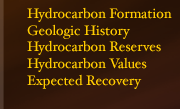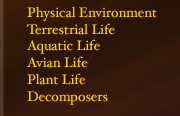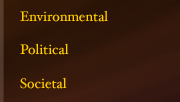
Environmental Implications - Muskoxen
Muskoxen (Ovibos moschatus) were driven to extinction before the 20th
century. They were reintroduced in 1969 and their numbers reached
a peak at almost 400 individuals in 1986. Since then, the muskoxen
population has declined to around 200 individuals. Reasons for
this population decline include emigration, increased predation by grizzly
bears, and severe winters. Also, hunting by humans has increased
since their reintroduction. (Patricia E. Reynolds, Kenneth J. Wilson,
and David R. Klein, 2002)
Population dynamics of Muskoxen
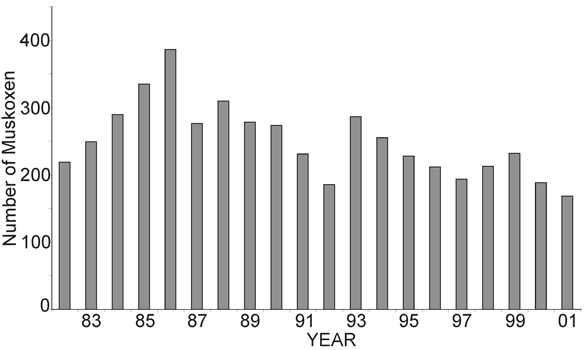
Graph: http://www.absc.usgs.gov/1002/images/Fig07-01.gif.
Muskoxen conserve energy by limiting their movement; they tend to stick
to a core area about 50 km2 in the winter and 200 km2 during the calving
and summer seasons. Calving occurs from March to June, so it is
especially important for mothers to build up enough reserves during
the summer to last the winter and to feed the newborn. Thus, a
prolonged winter would have significant negative impacts on calf survival.
Muskoxen depend on riparian cover along river corridors, floodplains,
and foothills year-round. During the winter, it seeks out areas
of soft shallow snow. Its winter diet consists mainly of low-quality
forage such as sedges, grasses, mosses, and forbs. In the spring,
it feeds on high quality flowering sedges. Muskoxen tend to be
very loyal to a particular spot, returning there year after year.
(Patricia E. Reynolds, Kenneth J. Wilson, and David R. Klein, 2002)
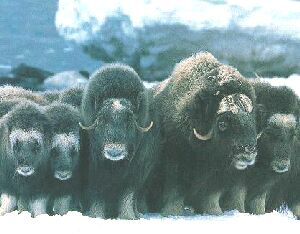
Muskoxen herd
(Photo: http://www.saskschools.ca/%7Egregory/arctic/Amuskox.html)
Any human activity should stay away from the muskoxen habitats, including
adjacent uplands. The areas that muskoxen frequent are places
often used for gravel and water extraction for roads and/or platforms.
Muskoxen congregate into larger groups in the winter, and large groups
of animals are more likely to be disturbed by human activity because
they tend to have more sensitive individuals.
Muskoxen groups that have moved west tolerate the Trans-Alaskan pipeline
and the Dalton highway, but it is due to the wider area of habitable
land available to the animals. Muskoxen remaining in the 1002
coastal plain are in a more geographically constricted habitat, with
the Beaufort Sea to the north and the Brooks Range to the south.
Eastern muskoxen populations are likely to suffer if human activities
displace their territories and there are few alternative habitats available.
(Patricia E. Reynolds, Kenneth J. Wilson, and David R. Klein, 2002)
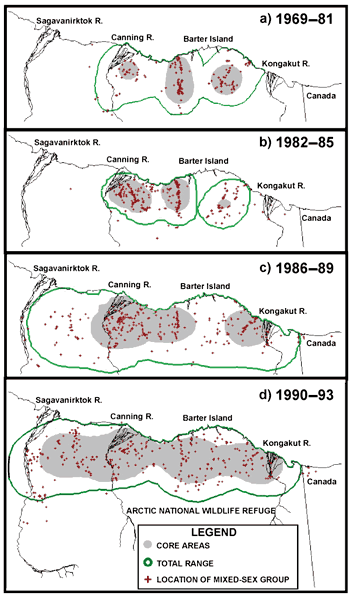
Range expansion of muskoxen in mixed-sex groups in and near the Arctic
National Wildlife Refuge, Alaska, 1969-1993. Total ranges were defined
by 95% adaptive kernel contours. Core areas were defined by 70% adaptive
kernel contours.
(Map: http://www.absc.usgs.gov/1002/section7part1.htm)
As muskoxen populations in the far west have coexisted peacefully with
the Trans-Alaskan pipeline, a similar pipeline through the 1002 region
should have little impact as well-- if it is built with the same environmental
precautions. For example, the Trans-Alaskan pipeline has 579 animal
crossings over its 800 mile span.
Helicopters and low-flying aircraft have been noted to cause some herds
to stampede and abandon their calves. Some herds have been agitated
by 3-D seismic exploration as far as three kilometers away; other herds
seem unperturbed as close as 300 m. Generally, noise produced
by traffic, etc will have a negative effect on the animals. (Patricia
E. Reynolds, Kenneth J. Wilson, and David R. Klein, 2002)
Little data are available on the interaction between muskoxen and human
settlement associated with oil development. This is because drilling
platforms have been built in regions rarely visited by muskoxen.
However, the nature of the muskoxen's normal food source is such that
its scavenging among human waste is unlikely. The major concern
is the gravel used for the platforms, which would have to be extracted
from muskoxen habitats.The specific impacts of seismic exploration on
muskoxen:
The population of muskoxen in the 1002 area is approximated to be about
250 muskoxen living all year long. The survival of muskoxen is
influenced by environmental conditions such as the depth of snow, which
is in turn greatly influenced by seismic exploration activities. In
general, the following effects are feared if exploration is to be
conducted in the 1002 area:
a. Displacement of muskoxen from their winter habitat.
b. Due to this displacement, there will be greater energy needs.
Muskoxen need to reduce their activity and movement during the winter
in
order to preserve their energy and survive.
c. Decreased body fat in females. This body fat must be maintained
during the winter if they are going to rear a calf.
d. Greater chances of predation.
e. As a consequence of the above, there will be decreased calf
production and less survival of the animals. Impacts of Oil Exploration
and Drilling on Lemmings and Voles
Lemmings and Voles tend to be more abundant and have less survival issues
than muskoxen. In the winter they live in large underground burrows
that may be as close as two inches from the permafrost. They subsist
on willow twigs, sedges, and stored tubers during the long winter season.
Burrows of voles are often raided by native peoples, who pilfer the
stored tubers for their own use. (John Whitaker Jr., 1996)
Because of their numbers lemmings and voles are not likely to be wiped
out by human activity in the region. However, they are an important
source of food for higher lever consumers, including polar bears, wolves,
and foxes. Lemming cycles, for example, are closely tied to the
population cycles of various predators. A sharp drop in their
numbers could potentially cause a population decrease in many other,
higher-level consumers. (John Whitaker Jr., 1996)Reference:
1. Patricia E. Reynolds, Kenneth J. Wilson, and David
R. Klein. (2002). Section 7, Arctic Refuge Coastal Plane Terrestrial
Wildlife Research Summaries
http://www.absc.usgs.gov/1002/section7part1.htm
http://www.absc.usgs.gov/1002/section7part2.htm
2. http://www.absc.usgs.gov/1002/section3part3.htm
3. http://books.nap.edu/books/0309087376/html/117.html
http://www.jpo.doi.gov/pthom/Environmental%20Report.pdf
Oil or Animals report
4. John Whitaker Jr. (1996). The National Audubon
Society Field Guide to North American Mammals

